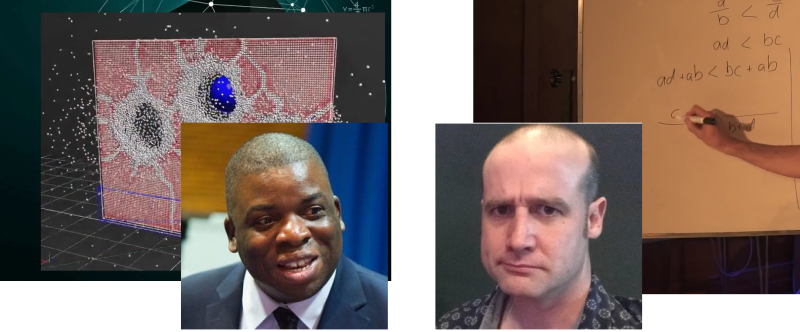The Big Internet Math-Off – The Final! Nira Chamberlain v Matt Parker
The Aperiodical 2018-08-02

Well, this is it: the final of The Big Internet Math-Off. Just one more match stands between the two remaining competitors and their destiny: the title of World’s Most Interesting Mathematician (modulo the previously described factors of knowing me, interest in taking part, and availability in July to indulge my whimsy).
Nira Chamberlain and Matt Parker each have one pitch left to wow you and get your little grey cells a-quivering. So what have they picked? Find out below!
There’s no twist in the format for the final round, the rules are the same as always: take a look at both pitches, vote for the bit of maths that made you do the loudest “Aha!”, and if you know any more cool facts about either of the topics presented here, please write a comment!
So, with all that said, let’s begin the final round of THE BIG INTERNET MATH-OFF!
 Nira Chamberlain – Mathematical modelling
Nira Chamberlain – Mathematical modelling
Dr Nira Chamberlain is an applied mathematician and maths outreach expert, and Vice President, Professional Affairs and Industry at the IMA. You can find him on Twitter at @ch_nira, or at nirachamberlain.com. In round 1 he saw off James Tanton with an application of the Reynolds equation to Formula 1 cars, and then in round 2 gave us a history lesson on the black heroes of mathematics. He won an incredibly closely-fought semi-final with a video on Schelling’s model of segregation.
Nira has made a video about mathematical modelling.
 Matt Parker – Naively adding fractions
Matt Parker – Naively adding fractions
Matt Parker is a standup mathematician with a lot of jobs. He’s one third of the scientific comedy group Festival of the Spoken Nerd, author of the book Things to Make and Do in the 4th Dimension, he sells mathematical toys at Maths Gear, he frequently features on Numberphile, and he does stuff for schools through Think Maths. You can find him on Twitter at @standupmaths, on YouTube, or at standupmaths.com. He got through round 1 with a pile of matchboxes that can play noughts-and-crosses, lost his sense of direction in round 2 with the projective plane, and upended the entire concept of competition in the semi-final with a pathological voting strategy that made the referee’s head hurt.
For me, the greatest joy in Mathematics is spotting something interesting and playing with it. Even the small and near-trivial. Anything is fair-game for a bit of extra mathematical exploration.
Anyone who has taught maths has seen students try to add fractions with the naively obvious method:
\[ \frac{a}{b} + \frac{c}{d} = \frac{a+c}{b+d} \]
One day I wondered what this ‘naive fraction sum’ actually represents.
It turns out it is always a new fraction between the two fractions $a/b$ and $c/d$.
I thought that was really nice. I’m sure there is some computing etc. reason why this might be useful but I saw it as something interesting to look into. So I set about to prove it and it’s a lovely little proof (for nice, non-pathological values of $a$, $b$, $c$ and $d$).
So it’s not big or profound and it’s not a massive crowd pleaser, but I like it. Do have a play with it yourself to find a proof. Or you can watch this video of me proving it:
So, which bit of maths has tickled your fancy the most? Vote now!
Note: There is a poll embedded within this post, please visit the site to participate in this post's poll.
The poll is now closed. Nira won!